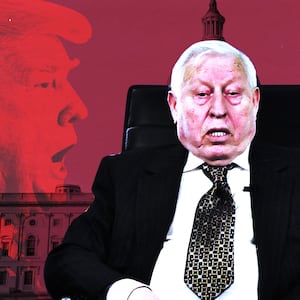KHARKIV, Ukraine—Night had fallen in this city less than 20 miles from the Russian border, and a crowd gathered around the offices of the State Security Service. From out of the dark, a tall, muscled-up, militant young man stepped forward to speak.
“We have stopped Russian forces advancing on our land, we’ll stop the treason: no to capitulation in this war,” 22-year-old Georgy Tarasenko proclaimed that night of Oct. 2 in a message and a motto that has resonated throughout the country. Recent days have seen thousands of people in the streets of the capital, Kyiv. “No capitulation!” they shout.
The sentiment is genuine and deep, but so is the desire for peace in a country that has fought for more than five years against a Russian-backed separatist movement at a cost of more than 13,000 lives.
ADVERTISEMENT
President Volodymyr Zelensky won his office earlier this year promising to end the war at almost any cost. But the price has gone up as his position has weakened, and he appears ready to sign a peace agreement very much on Russian terms. That is due in no small measure to the unreliability of Ukraine’s most important supporter, the United States.
Until last month, President Donald Trump held up vital military aid while his personal lawyer, former New York Mayor Rudolph Giuliani, twisted arms in Ukraine while looking for dirt on Democratic presidential frontrunner Joe Biden and grasping for information that somehow Ukraine, not Russia, set out to deform American democracy. A phone call between Trump and Zelensky in July that touched on these issues is now at the center of impeachment proceedings against Trump in Washington.
Importantly, people believe the games that Trump and Giuliani have been playing with Ukraine have led to a sellout of Russian-annexed Crimea and the embattled Donbas region of eastern Ukraine. For critics here, the most damning evidence came when Trump met Zelensky on the sidelines of the United Nations General Assembly last month.
“During the meeting in New York, Trump told our President Zelensky to ‘get together and solve your problem’ with Putin, so now we see how Zelensky is pushing to fulfill that request, “ Galina Odnorogo, one of the protesters on the Maidan, Kyiv’s Independence Square, told The Daily Beast. Odnorogo traveled from the war-troubled Donbas region to join the rallies. “We are blaming Trump for putting pressure on our president in these peace negotiations.”
But there’s a problem with a movement where characters like the buff Mr. Tarasenko have pushed themselves into the foreground. Tarasenko, for instance, is a leader of Freikorps in Kharkiv, a group best known for gay-bashing and fights with police during a pride march. “All our members are of Ukrainian nationality, other nationalities do not want to join us because of our views; there is nobody more far-right than us in Kharkiv,” he told The Daily Beast.
Such people play directly into the hands of Russian propagandists who denounce “a neo-Nazi effort to stoke chaos.”
Protests by war veterans, nationalists, and pro-European integration groups began just hours after a representative of Ukraine, former President Leonid Kuchma, signed a letter in Minsk, Belarus, on Oct. 1 addressed to the Organization for Security and Cooperation in Europe (OSCE) confirming the so-called Steinmeier Formula, named for a former German president.
This opens the way for snap elections in the self-proclaimed Russian-backed separatist republics of Luhansk and Donetsk but makes no mention of withdrawal by pro-Russian military forces. It doesn’t talk about Ukraine regaining control of the nearly 400-kilometer (250-mile) border with Russia. Discussion of Crimea is left for some later date.
In 2014, Russia used unidentified troops (“little green men”) to take over the strategic peninsula, rigged up a referendum, and summarily annexed Crimea in a matter of weeks, precipitating international sanctions on Russia that have lasted to this day.
Natalia Isupova, a Kyiv school teacher, is one of the moderate voices joining the “No Capitulation” protests. “I don’t think it would be possible to hold elections in the occupied east [the Donbas region]. This is a scenario of the Crimea referendum,” Isupova said.
Isupova also questions an earlier document signed by Russia and Ukraine after negotiations during the most violent months of 2014 and 2015, the so-called Minsk agreements detailing the conditions for ceasefire.
“Four years ago we signed a bad document to stop the killing of people,” said Isupova. But the killing has gone on, albeit at a lower level. “All this time Ukraine has been prioritizing security issues over the political questions. And now vice versa, our leadership first wants to run elections and then solve the security issues, then take control over the border.”
Many in Ukraine think hopes for such future developments are illusory, given Russian President Vladimir Putin’s growing confidence in the face of America’s evident vacillation and weakness. If the elections in eastern Ukraine do not lead to outright annexation, as happened in Crimea, they could open the door to the kind of quasi-independent Russian satellites Moscow has established in formerly sovereign territories of Moldova (Transnistria) and the Republic of Georgia (Abkhazia and South Ossetia).
The creation of quasi-states carved out of territory belonging to other nations is a favorite strategy for Moscow. Indeed, Russia and Turkey—and the Trump administration—appear to be collaborating right now to establish a similarly problematic territory in northern Syria. But the creation of these territories whose sovereignty is left in limbo doesn’t lead to lasting resolutions of conflict. Instead, they create a false peace that thwarts the chances for a real peace.
The document signed by Kuchma was written as a formal response to a letter from Ambassador Martin Sajdik, special representative of the OSCE, sent out on September 11. Coincidentally, perhaps, this was precisely the same moment that the Trump administration agreed to release $250 million in aid to Ukraine it had held up in hopes Zelensky would provide support for its conspiracy theories about the Democratic Party.
In the event, the suspension of U.S. aid, then its release, may have encouraged Zelensky to agree to the terms of the letter endorsing the so-called Steinmeier Formula, which is named after the current president of Germany, Frank-Walter Steinmeier, who helped negotiate it when he was foreign minister. Russia and Ukraine have been discussing those terms for years, but until now Kyiv had, indeed, seen them as a form of surrender.
Russian state media headlined “Ukraine has compromised,” which to this country’s war veterans, and others, sounded like betrayal.
Many liberal activists, corruption fighters, and journalists are just as worried as far-right protesters about the future status of the separatist regions, but they are also concerned about the growing crowds of angry veterans on the streets.
“There is a huge risk of armed protests growing violent,” anti-corruption activist Daria Kaleniuk told The Daily Beast. She said she was concerned as well that in eastern Ukraine “security cannot be guaranteed in the occupied territories, where population has been living with Russian propaganda for years.”
President Zelensky’s popularity rating dropped from 77 percent in September to 66 percent, and the protest movement appears to have made the difference not only in the polls but on the ground. Zelensky’s office decided to postpone the disengagement of forces near the town of Zolote, where according to Ukrainian news reports pro-Russian forces continued to shell in violation of earlier agreements.
Zelensky, a former television comedian with no prior political experience, says peace talks have nuances and the local elections in separatist regions of Donetsk and Luhansk “will be held in accordance with the Ukrainian constitution and legislation.” He also said that Kyiv would allow elections in separatist regions only if monitors from the OSCE determined they are fair.
The Ukrainian president told his people the letter Kuchma signed was not the final word, that it was up to the Ukrainian parliament to decide the final version: “That is why there will never be any capitulation.”
At an unusual 14-hour “press marathon” in a trendy Kyiv food market last week, Zelensky repeatedly tried to calm concerns about the path he’s chosen, but he left little doubt about the weakness of his government’s position.
When journalists asked Zelensky to admit that Ukraine for the last five years has been at war not just with separatists but with the Russian Federation, he said, “Then we’d have to start the war in Crimea,” since Moscow now claims the peninsula as part of its sovereign territory. “Our army is not ready and I am not, as the president, ready to lose our people.”
He reminded reporters, “I was coming [to politics] as the president of peace.”
Every day, Ukrainians are reminded of the violence in Donbas. “Almost every week more people die and we update our data in the aftermath,” Gennady Sherbak, the founder of Peaceful Bank (Mirny Bereg), told The Daily Beast. At the time of our conversation last week, his website included the names of 4,543 dead Ukrainian soldiers, 2,892 dead civilians and 4,643 dead separatist militias. “We also have lists of more than 1,300 disappeared people,” he said.
Ukrainian MP Valentyn Nalyvaichenko says that the parliament has a clear position: “We first need to see the deoccupation process that would require all aggressor’s forces and special services leave the territory; and only after the territory is free could we have snap elections,” Nalyvaichenko said.
So far, Russia has not agreed to that condition.







